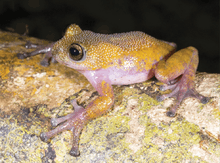Gracixalus lumarius
| Gracixalus lumarius | |
|---|---|
 | |
| Scientific classification | |
| Kingdom: | Animalia |
| Phylum: | Chordata |
| Class: | Amphibia |
| Order: | Anura |
| Family: | Rhacophoridae |
| Genus: | Gracixalus |
| Species: | Gracixalus lumarius Rowley et al. 2014 |
Gracixalus lumarius also known as the thorny tree frog is a species of rhacophorid frog discovered in 2014 that is native to Vietnam.[1][2]
Etymology
Gracixalus Lumarius (lat. lumārius, associated with the thorns) is named after their extensive conical tubercles on the dorsum of the male.
Description

Gracixalus Lumarius is a medium-sized rhacophorid.The species has a strong sexual dimorphism. From the snout to the vent Adult females measure about 36 millimeters,[3] while the males are larger with about 38-41 millimeters.[3] The Head of Gracixalus Lumarius is wider than long, while viewed dorsally its snout is rounded. Their dorsum has a colour between brown and dark yellow, their vent is pink. The pupil is horizontal and oval, while their Iris is gold.
The back and the head of the males displays tuberculated skin with keratinized spikes, which is often referred as a sandpaper skin.[4] This specific dorsal structure is name giving and shows the male's breeding readiness. Females have a constant clear, smooth skin. Gracixalus Lumarius is a phytotelma breeder it deposite their Eggs above water on walls of them. Females lay about 130 blue-gray Eggs.
Habitat
Gracixalus Lumarius is known to live underwater in tree holes. Its natural habitat is in the relatively undisturbed montane bamboo and evergreen forests on a height of 5,900 feet and in the surrounding area of Mount Ngoc Linh (Vietnam).[5]
Status
Gracixalus Lumarius is an endangered (EN) species.[6] The geographical range with a extent of occurrence of 426 km2 is very restricted. There is an ongoing decrease in populations due to further habitat loss and degradation. One reason for this is the conversion of forest to agricultural land. There is a high probability that the gold mining activity has also an influence on the forest quality. Half of their extent of occurrence is unprotected, so the natural habitat is endangered.
References
- ↑ http://newswatch.nationalgeographic.com/2014/04/03/new-frog-species-vietnam-animals-science-world/
- ↑ Jodi J. L. Rowley, Duong Thi Thuy Le, Vinh Quang Dau, Huy Duc Hoang, Trung Tien Cao (2014). "A striking new species of phytotelm-breeding tree frog (Anura: Rhacophoridae) from central Vietnam" (PDF). Zootaxa. 3785 (1): 25. doi:10.11646/zootaxa.3785.1.2.
- 1 2 "A striking new species of phytotelm-breeding tree frog" (PDF). Zootaxa.
- ↑ "New Species: Pink-and-Yellow Frog With Spikes". National Geographic (blogs). Retrieved 2016-04-07.
- ↑ "AmphibiaWeb - Gracixalus lumarius". amphibiaweb.org. Retrieved 2016-04-07.
- ↑ IUCN. "Gracixalus lumarius: IUCN SSC Amphibian Specialist Group". IUCN Red List of Threatened Species. doi:10.2305/iucn.uk.2015-4.rlts.t73726400a73726406.en.